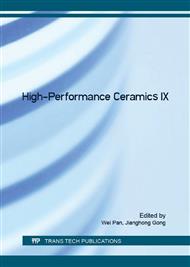[1]
D.M. Zhang, J. Chang. Electrospinning of Three-Dimensional Nanofibrous Tubes with Controllable Architectures, J. Nano Lett. 2008, 8 (10): 3283-7.
DOI: 10.1021/nl801667s
Google Scholar
[2]
S. Koombhongse, W.X. Liu, D.H. Reneker. Flat polymer ribbons and other shapes by electrospinning, Journal of Polymer Science Part B-Polymer Physics. 2001, 39(21): 2598-606.
DOI: 10.1002/polb.10015
Google Scholar
[3]
D. Sun, J. Lang, X. Yan, L. Hu, Q. Xue. Fabrication of TiN nanorods by electrospinning and their electrochemical properties, Journal of Solid State Chemistry. 2011, 184(5): 1333-8.
DOI: 10.1016/j.jssc.2011.03.053
Google Scholar
[4]
E. Formo, P.H.C. Camargo, B. Lim, M. Jiang, Y. Xia. Functionalization of ZrO2 nanofibers with Pt nanostructures: The effect of surface roughness on nucleation mechanism and morphology control, Chemical Physics Letters. 2009, 476(1-3): 56-61.
DOI: 10.1016/j.cplett.2009.05.075
Google Scholar
[5]
R. Ruiz-Rosas, J. Bedia, J.M. Rosas, M. Lallave, et al. Methanol decomposition on electrospun zirconia nanofibers, Catalysis Today. 2012, 187(1): 77-87.
DOI: 10.1016/j.cattod.2011.10.031
Google Scholar
[6]
M. Su, J. Wang, H. Du, et al. Characterization and humidity sensitivity of electrospun ZrO2: TiO2 hetero-nanofibers with double jets, Sensors and Actuators B-Chemical. 2012, 161(1): 1038-45.
DOI: 10.1016/j.snb.2011.12.005
Google Scholar
[7]
S. Zhuiykov, N. Miura. Development of zirconia-based potentiometric NOx sensors for automotive and energy industries in the early 21st century: What are the prospects for sensors, Sensors and Actuators B-Chemical. 2007, 121(2): 639-51.
DOI: 10.1016/j.snb.2006.03.044
Google Scholar
[8]
M. Maczka, E.T.G. Lutz, H.J. Verbeek, et al. Spectroscopic studies of dynamically compacted monoclinic ZrO2, Journal of Physics and Chemistry of Solids. 1999, 60(12): 1909-14.
DOI: 10.1016/s0022-3697(99)00221-8
Google Scholar
[9]
R. Hansch, M.R.R. Chowdhury, N.H. Menzler. Screen printing of sol-gel-derived electrolytes for solid oxide fuel cell (SOFC) application, Ceramics International. 2009, 35(2): 803-11.
DOI: 10.1016/j.ceramint.2008.02.020
Google Scholar
[10]
M. Zhi, N. Mariani, R. Gemmen, K. Gerdes, N. Wu. Nanofiber scaffold for cathode of solid oxide fuel cell, Energy & Environmental Science. 2011, 4(2): 417-20.
DOI: 10.1039/c0ee00358a
Google Scholar
[11]
J. Li, X. Jiao, D. Chen. Preparation of zirconia fibers via a simple aqueous sol-gel method, Journal of Dispersion Science and Technology. 2007, 28(4): 531-5.
DOI: 10.1080/01932690701277120
Google Scholar
[12]
C.L. Shao, H.Y. Guan, Y.C. Liu, et al. A novel method for making ZrO2 nanofibres via an electrospinning technique, Journal of Crystal Growth. 2004, 267(1-2): 380-4.
DOI: 10.1016/j.jcrysgro.2004.03.065
Google Scholar
[13]
D. Qin, G. Liang, A. Gu, L. Yuan. Fabrication of SiO2 covered ZrO2 electrospun fibres with controllable structure and their novel high-performance composites with outstanding thermal, mechanical and dielectric properties, Journal of Composite Materials. 2014, 48(26): 3201-14.
DOI: 10.1177/0021998313507619
Google Scholar


